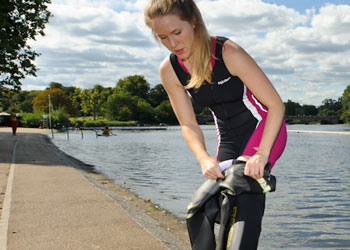Jim is an accomplished triathlete and endurance cyclist, and has raced in more than 35 USAT-certified races. He is also an avid trail runner and endurance gravel bike rider. Jim is a founder of Complete Tri and frequent writer on triathlon and cycling.
Taking a wetsuit off, whether during a triathlon or after a training session, is something that can take a little practice. Wetsuits are designed to be very snug and keep you warm in the water. That snug fit isn’t always conducive to quick wetsuit removal during Transition 1, especially when you exit the water winded and perhaps with your energy waning. For those who haven’t done it often, a few pointers are in order before you create bad habits.
Higher-end wetsuits tend to be constructed in a way that allows for more effortless and faster removal. Cheaper wetsuits are going to be less forgiving and require a bit more
While perhaps the best way to learn fast methods of wetsuit removal is by observing elite triathletes during a race, here are a few pointers that can help anyone remove their wetsuit with ease.
Use Body Glide – It Helps
First, the process of easy wetsuit removal begins when you put the wetsuit on. Before a swim or a triathlon, be sure to use some body glide on key areas such as ankles to help the wetsuit slide off easier when the time comes to remove it. Also, be sure you pay attention to the placement of your zipper strap. I like to tuck mine in to the back of my wetsuit keeping a 5-6 inch loop sticking out for easy access. Allow enough time to put your wetsuit on carefully and with no major rush. When you rush, you do little things like get some fabric in the zipper, or forget about zipper strap placement, all things that will no doubt add time to the process of taking a wetsuit off later.
Unzip the Back, Remove Your Arms
 After you have completed your swim, the time comes for wetsuit removal. Reach back for your zipper strap, undo any Velcro covering it (if your wetsuit has it) and give the zipper strap a nice, firm pull downward. Pull it all the way down so the zipper can’t go any further. At this point, you should be able to pull your arm out of one sleeve while holding it with your other hand, and vice versa. This entire maneuver can be done while you are on the run, and will get your wetsuit stripped down to your waist.
After you have completed your swim, the time comes for wetsuit removal. Reach back for your zipper strap, undo any Velcro covering it (if your wetsuit has it) and give the zipper strap a nice, firm pull downward. Pull it all the way down so the zipper can’t go any further. At this point, you should be able to pull your arm out of one sleeve while holding it with your other hand, and vice versa. This entire maneuver can be done while you are on the run, and will get your wetsuit stripped down to your waist.
Step out of the Legs
Once you are back to your transition area, you can finish the job. Pull the wetsuit down past your hips and roll each leg down as far as you can while standing. Sitting is OK as well but will add time to your transition. Firmly but quickly pulling each leg down should get the wetsuit to about your knees or high shins. At this stage, we recommend simply stepping on the wetsuit and pulling each leg off past your ankle, much like you might with tights or a long pair of socks. Much like with removing something like compression socks, you can’t just pull the ends — you need to help “peel” the suit off in spots. You don’t have to be terribly careful, just be sure you are not standing on rocks, sticks or other sharp objects. Be sure to then put your wetsuit out of your way or the way of other triathletes. Many racers have stories of coming back to their transition spot, only to find their biking or running gear soaked from a carelessly placed wetsuit.
Don’t Tear the Suit!
With all of these steps, always take care to not have your fingernails dig in to the wetsuit and make sure there are no sharp rocks or twigs nearby. Wetsuits can be ripped easily. Higher-end wetsuits are unfortunately no more durable than entry-level ones, since they often have thinner neoprene in spots. The main thing to remember is that adding a few seconds to your T1, and slowing down, might save your wetsuit for years to come.
Practice
Finally, don’t forget to practice. Triathletes often view practice as something that only applies to swimming, biking and running. But practicing things like taking a wetsuit off can be real difference-maker in a competition when the difference between you and the person a spot ahead of you is only 5 or 10 seconds. Practice alone, because nobody will be helping you take the suit off on race day! The difference between a fast wetsuit removal and a botched one could easily be a minute or more.







